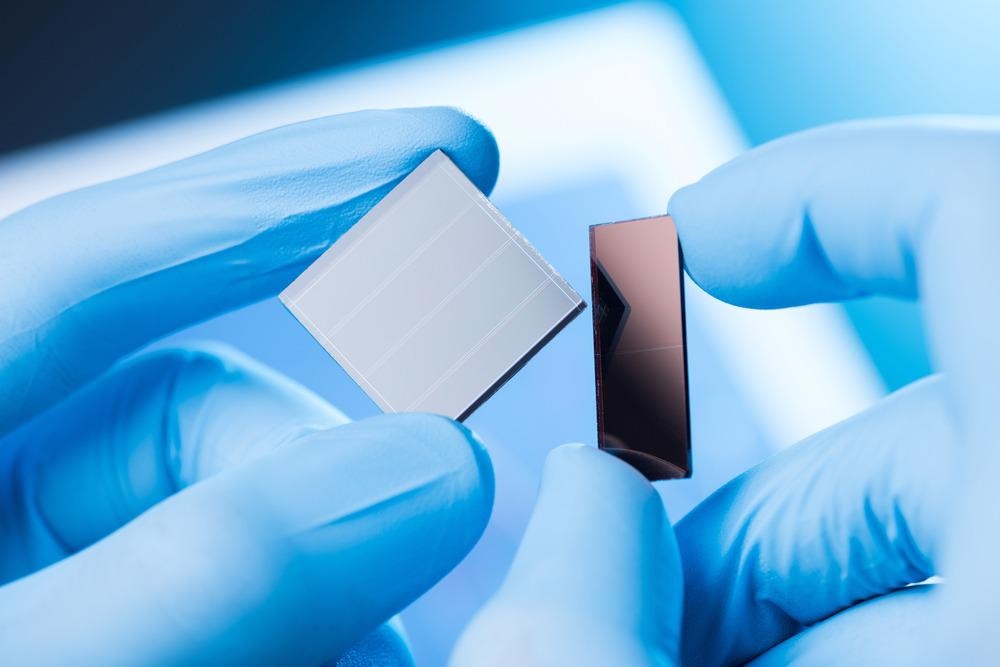Chalcogenide perovskites are materials that can be used for many applications. The ability to produce high-quality films of many other semiconductor families has paved the way for computer devices, photovoltaic panels, night-vision cameras, and other applications.

Image Credit: nevodka/Shutterstock.com
The advanced semiconductor group recognized as chalcogenide perovskites might have applications in photovoltaic modules and lighting.
These materials are ultra-stable and formed of nontoxic, low-cost materials. Researchers have created these thin films made of barium, zirconium, and sulfur in a specific crystalline structure. The structure can be changed by the researcher to produce different results. Therefore, it is a material family group that can be used in many applications.
History of Chalcogenide Perovskites
The invention of calcium titanate (CaTiO3) by Russian mineralogist Perovski in 1839 was thought to be the beginning of perovskite. French chemists developed chalcogenide perovskites as early as the 1950s. Similar research was conducted in the 1980s and early 1990s, but the concept of how these materials would have been useful semiconductors did not emerge until the early 2010s.
Chalcogenide Perovskites Now
Lead-based organic-inorganic hybrid perovskites have recently become very popular, as they have climbed the solar cell efficiency graph and achieved comparable performance to more advanced technologies such as crystalline silicon. Chalcogenide perovskites are an unusual type of ionic semiconductor.
Anion alloying could be used to systematically adjust the band gap values of the components. BaZrS3 is a stable and ubiquitous semiconductor that could be used in photovoltaics. The components of the band edges in chalcogenide perovskites are constrained merely by the B-site cation d-states and chalcogen p-states, equivalent to lead hybrid halide perovskites, whereas the A-site cation bands appear densely concentrated and deep.
Strong absorbance in the solar spectra and electronic configuration indicative of easy charge-transport are examples of this. Above everything else, as with other inorganic chalcogenides often used in PV, the new finding chalcogenide perovskites have a high degree of thermodynamics and atmospheric stability. Caused by structural similarities, chalcogenide perovskites have similar optoelectronic capabilities to effective lead-based perovskites.
New Findings by MIT, High-Quality Chalcogenide Perovskites
An MIT present investigation provides high-quality films of BaZrS3 chalcogenide perovskites, which exceed expectations as a new semiconductor favorable for a variety of applications, such as photovoltaic and green lighting. The MIT researchers created the prototypical chalcogenide perovskite in a barium, zirconium, and sulfur crystal structure. By varying the composition of the perovskite, several variations can be created, laying the foundation for the development of a group of materials to be used as semiconductors.
The films were created using molecular beam epitaxy (MBE), a difficult method that allows crystal growth to be monitored at the atomic scale. A beam of particles is directed at atoms organized on the material during MBE. The atoms' specific arrangement acts as a blueprint for the particles to implement as they grow.
What Happens When the Shape of Chalcogenide Glass Changes?
The films were grown in two ways by the researchers. To alleviate epitaxial strain, they were using buffered epitaxy with the self-assembled interfacial layer, as well as direct epitaxy. To facilitate the lattice mismatch between both the oxide substrate and the sulfide perovskites, the latter method allowed for rotated-cube-on-cube growth.
Chalcogenide Perovskites Properties
This new study analyzed the structural, spectroscopy, and electrical properties of chalcogenide perovskites, as well as their computational and synthetic advances. Algorithmic studies consistently show the presence of a wide range of stable chalcogenide perovskites with large bandgaps and higher adsorption coefficients acceptable for single-junction PV devices.
In addition, detailed first-principles research findings on some of these chalcogenide perovskites demonstrate the shallow essence of intrinsic defects and reach the conclusion of the potentiality of fine-tuning the optical and transport properties through B-cation and anion mixing.
Future Research Recommendation
Researchers have proposed recommendations for the future of the sector, emphasizing the importance of focusing mostly on the preparation of chalcogenide perovskites, with a particular interest in a deeper understanding of phase chemical reactions to obtain mixed cation and anion configurations, which show the most potential. Researchers specifically recommend investigating the mixed B-cation compositions because a vast majority of machine learning studies to date have concentrated on Zr and Hf perovskites.
Bandgap structure in chalcogenide perovskites has been demonstrated to be feasible through cautious compositional control, and that should be broadened through calculation and experimentation to provide a broader range of compositions, as recognized here. Further fabrication and characterization methods of thin films would be a significant step toward closing the gap among bulk and thin-film characteristics, allowing for the development of tailored materials for solar cell applications.
References
Tiwari, D., et al. (2021). Chalcogenide perovskites for photovoltaics: current status and prospects. Published 12 May 2021. Journal of Physics: Energy, Volume 3, Number 3. https://iopscience.iop.org/article/10.1088/2515-7655/abf41c
Thomson, E. (2021). Engineers report a major advance in creating a new family of semiconductor materials. Published online: November 3, 2021. MIT News. https://news.mit.edu/2021/engineers-report-major-advance-new-family-semiconductor-materials-1103
Disclaimer: The views expressed here are those of the author expressed in their private capacity and do not necessarily represent the views of AZoM.com Limited T/A AZoNetwork the owner and operator of this website. This disclaimer forms part of the Terms and conditions of use of this website.